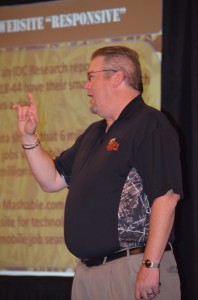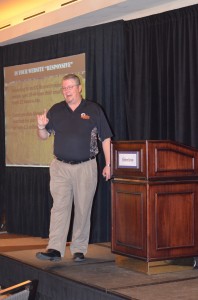 “We have to become headhunters again.” With that call to action, Greg Doersching opened the 2013 Fordyce Forum, telling a packed room during his morning keynote here in Dallas that business as usual isn’t the way to do business anymore.
“We have to become headhunters again.” With that call to action, Greg Doersching opened the 2013 Fordyce Forum, telling a packed room during his morning keynote here in Dallas that business as usual isn’t the way to do business anymore.
The 10 jobs most in demand in 2010, Doersching observed, didn’t even exist a scant few years before. The Millennials now entering the workforce will have at least 10 jobs, and as many as 14, before they’re 38. “This is going to be the new norm,” he said.
Everything has to be invented anew. But with the dramatic demographic changes now upon us — a loss of one-third of the workforce in barely 15 years — “We can’t just keep doing what we have been doing and expect it’s still going to work for us,” he said.
As he “unfogged the future” for the gathering of search firm owners and leaders, Doersching detailed four areas that, he said, “demand our attention”:
- Technology.
- Process Improvement.
- Service Offerings.
- Training.
Technology
“We’re spending about one-tenth of what we should be on technology,” said Doersching. Not only must agency websites be updated now, they need to be overhauled so that they attract candidates as well as clients. They need to offer value, be, if not ever-changing, freshened often enough that they will be enticing and current, and they must be designed for mobile, tablets, and PCs. And it has to be accessible to your recruiters 24/7 so they can work remotely when they need to and when they want to; not just when they are in the office.
The bottom line? “Your website has to be cool.”
But at the same time, as technology and services like LinkedIn make sourcing easier, recruiters have come to depend on them to the point that everyone can turn up the same candidates. The LinkedIn profile, Doersching reminded the audience, “is not a resume.” Updates can be infrequent, and much detail can be left out, so recruiters have to use the phone and actually talk with candidates about their skills, their interests and their motivations. In other words, “We have to headhunt.”
 Process Improvement
Process Improvement
Sloppy casualness is out and formality, or more precisely, professionalism is in. “I want to be more like an attorney than a used car salesman,” Doersching said. It differentiates you, he explained, from other agencies and recruiters, and encourages clients to not only regard you and your services more seriously, but prompts them to step up their game.
Professionalize all the materials you send, especially submittals and interviews. It’s been a long time since he sent a client an email submittal with just a few words and a candidate’s resume. Now, he prepares a report that highlights the relevant parts of the resume, provides a grid analysis of the candidate’s skills and know-how comparing them to the job requirements, supplemental information and at least one reference check. He does the same for the interview, sending the candidate a written series of debriefing questions as soon as the interview is done.
He sends a weekly progress report with enough detail that he finds his HR contacts will often send them directly to the hiring manager, which can sometimes open up a direct dialog. Everything is professional looking and formal.
Service Offerings
“You can not stay just a direct hire recruiter anymore,” Doersching said without hesitation. With Baby Boomers retiring in ever increasing numbers, and too few replacements in such key areas as sciences, technology, engineering and math, companies will be insisting on project workers to fill gaps. And that means many retirees will be lured back, but will only want to work on short term assignments. Agencies that offer contract workers stand to make money even when they can’t find the direct hires. These will be the firms that will prosper in the coming years.
Training
Pointing to an industry turnover rate as high as 85% for new hires, Doersching said the old school training method — observe and copy the practices of the office’s big producers — has to be supplemented, if not replaced. “It takes two full years,” said Doersching, to full train a recruiter. Instead of having a new hire go sit next to a big producer, provide them real training for the first two weeks with no client nor candidate training.
Watching a vendor video on entering and retrieving data from an ATS or CRM “makes no one an expert,” said Doersching. That alone can take several hours. After those two weeks, give a written test. Then for next nine weeks they work under supervision as formal training continues. His two year outline included periodic written tests, “learning and reviewing the way they have for most of their life.”
“We have to change,” Doersching told the Fordyce audience. “The future is going to be challenge. Everyone in this room is up to it.”